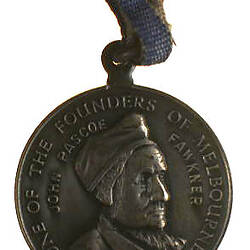Collingwood is an industrial and residential suburb 3 km north-east of Melbourne. It was named after Admiral Lord Collingwood, who fought at Trafalgar. On its east are Clifton Hill and Abbotsford, both included in the former Collingwood municipality. Its western boundary is Smith Street, Fitzroy, and its southern boundary is Victoria Parade.
Collingwood became a municipality on 24 April 1855, originally named East Collingwood. It was proclaimed a town in 1873, and on 14 January 1876 Collingwood became a city. It was abolished in 1994.
Collingwood was subdivided in 1838 into allotments of about 12 hectares each. Buyers of the allotments further subdivided them for resale, and by 1854 nearly all but the swampiest parts were subdivided. The flat topography made subdivision easy. Settlement intensified after the gold rushes, the exemption from building control laws encouraged the concentration of cheap houses on small blocks of land. East Collingwood was frequently flooded from stormwater run-off from the increasingly developed Fitzroy, and impervious subsoil caused stagnant sheets of water. Melbourne City Council, which until 1855 had jurisdiction over Collingwood, neglected calls for proper drainage.
The Yarra River in Collingwood's east attracted industry. In 1840 John Dight built a flour mill; wool washing also harnessed the river. Local councillors fought to repeal of laws for Yarra River water purity, arguing that effluent from noxious trades was merely adding to the sewage from Fitzroy. They argued in favor of economic development and employment for workers after the gold boom.
Collingwood municipality's population nearly doubled between 1871 and 1891 to 35,000 people. The town hall was transferred from the site now occupied by the TAFE to more opulent premises in Hoddle Street in 1885. Small houses proliferated. South of Alexandra Parade there were fifteen houses per acre compared with about half that density in neighbouring Clifton Hill. The Collingwood area was Victoria's biggest brewing centre after Melbourne.
After 1890 Collingwood's population stabilized. Some old shacks were demolished for factories, such as the Foy and Gibson's factory and Gibsonia woollen mills. A train service direct from the city to Collingwood was opened in 1901, opening Collingwood's factories to a wider workforce. A tram also ran along Johnston Street from 1887 to 1939.
Collingwood gained a reputation for working-class culture and tenacious support for the local football team. It continues to maintain a high level of club membership.
In the postwar years there was an exodus of residents from inner suburbs, to some extent drawn to outer suburbs by new Housing Commission developments. The inner suburban cottages were taken by postwar migrants. In 1967-71 twenty-storey blocks were built housing over 2,000 people, almost halting the municipality's population decline.
By the 1990s Collingwood was becoming gentrified. Housing prices reflected the change, although Collingwood remained a focus for people of lower economic status.
On 22 June, 1994, Collingwood city was united with Fitzroy and Richmond cities to form Yarra city.
In 1955 the City of Collingwood issued a medal to celebrate its centenary [NU 34528] .
References:
Australian Places website, Monash University http://www.arts.monash.edu.au/ncas/multimedia/gazetteer/list/collingwood.html, accessed 17/10/2003.
More Information
-
Keywords
-
Localities
-
Authors
-
Article types

